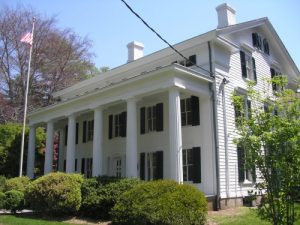
In April 1775 the Fairfield, Connecticut, mansion of the Honorable Thaddeus and Eunice Burr was a-bustle. Preparations were being made to welcome a contingent of key patriots: John Hancock, Samuel Adams, Lydia Hancock and Dorothy Quincy.
Word had reached Burr (who was High Sheriff of the County), Colonel Gold Selleck Silliman (he hadn’t yet been promoted to General) and Mr. Jonathan Sturges about a skirmish in Lexington and Concord. Rather than stay and risk imprisonment or worse at the hands of the British, the party fled to Fairfield.
Dorothy, the daughter of Judge Edmund Quincy and Elizabeth Wendell Quincy, together with Lydia Hancock, remained in Fairfield. Dorothy “continued at Fairfield, charming the townspeople by her beauty and graciousness, yet with a touch of stateliness that was inherent in her; and she was the ornament of Mr. Burr’s entertainment,” wrote Quincy’s great-great niece.[1]
As president of the Continental Congress, John Hancock was often absent from his fiancée Dorothy Quincy, whom he nicknamed Dolly. During the summer of 1775 they pair shared an epistolary romance.
“My dear Dolly – I am almost prevail’d on to think that my letters to my Aunt and you are not read, for I cannot obtain a reply, I have ask’d a million questions and not an answer to one, I beg’d you to let me know what things my Aunt wanted and you, and many other matters I wanted to know, but not one word in answer. I Really Take it extreme unkind, pray, my dear, use not so much Ceremony and Reservedness, why can’t you use freedom in writing, be not afraid of me, I want long Letters….”[2]
Other visitors to the stately house included General George Washington. On June 28, 1775, Washington passed through Fairfield en route to Cambridge, Massachusetts. He paid his respects at the Burr mansion; he knew Dorothy and her parents, according to a 1915 book about the house.[3] Later that summer Hancock returned to the home and on August 28, 1775, the couple married.
The gracious, well appointed home would not stand for the duration of the war. In July 1779 Eunice Burr hid in a marsh and watched as the British burned her and her husband Thaddeus’ beloved home and its contents. Heavy clouds of smoke billowed into the sky.
The British troops set Fairfield afire as punishment for the town’s part in the war. General Tryon’s men even stole Eunice Burr’s silver buckles from her shoes and gold sleeve buttons from her wrist.[4]
Gone was the house where such illustrious figures as George Washington, Samuel Adams, John Adams and Aaron Burr had crossed once crossed the threshold. Gone was the house where in 1775 Massachusetts Governor John Hancock, a longtime friend of the Burrs, wed Dorothy Quincy, considered Boston’s “reigning belle.”
After the fire Hancock visited his friend Thaddeus Burr. Together they surveyed the ruins. After their walk Hancock urged his friend to rebuild, offering to supply the needed glass “provided he would build a house precisely like his own in Boston.”[5] Burr, a wealthy landowner, accepted the offer and rebuilt an exact copy of Hancock’s home.
After Thaddeus died in 1801, General Gershom Burr inherited the mansion. During the ensuing years the house changed hands several times and underwent several alterations.
Today the Town of Fairfield owns the property and Fairfield Museum and History Center manages the 15-room mansion, which has a ballroom and sunroom. The house and its graceful gardens can be rented for weddings and receptions.
[1] Ellen C. D. Q. Woodbury, Dorothy Quincy, Wife of John Hancock with the Events of Her Time (Washington, DC: Neale Publishing Company, 1901), 80.
[2] John Hancock to Dorothy Quincy. New England Magazine: An Illustrated Monthly 6 (March 1892), 532.







Recent Articles
Joseph Warren, Sally Edwards, and Mercy Scollay: What is the True Story?
This Week on Dispatches: David Price on Abolitionist Lemuel Haynes
The 1779 Invasion of Iroquoia: Scorched Earth as Described by Continental Soldiers
Recent Comments
"Contributor Question: Stolen or..."
Elias Boudinot Manuscript: Good news! The John Carter Brown Library at Brown...
"The 1779 Invasion of..."
The new article by Victor DiSanto, "The 1779 Invasion of Iroquoia: Scorched...
"Quotes About or By..."
This well researched article of selected quotes underscores the importance of Indian...